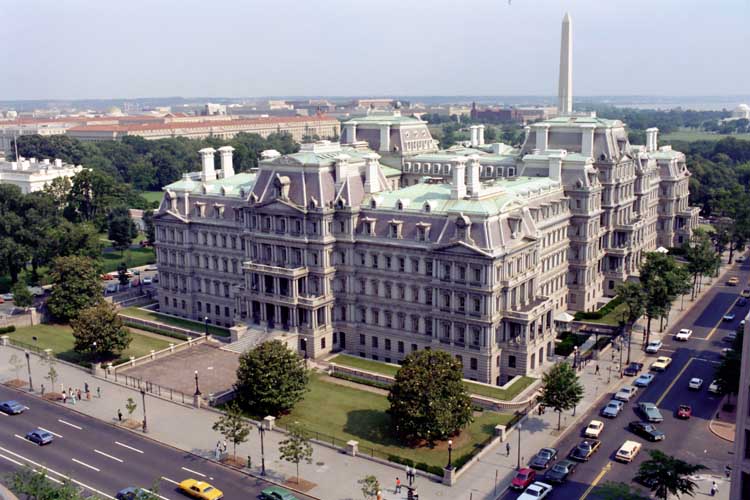According to the National Register of Historic Places, the building—originally called the State, War, and Navy Building because it housed the Departments of State, War, and the Navy—was built between 1871 and 1888 in the French Second Empire-style. It was designed by Alfred B. Mullett, Supervising Architect.
The Old Executive Office Building was renamed the Dwight D. Eisenhower Executive Office Building when President Bill Clinton approved legislation changing the name on November 9, 1999. President George W. Bush participated in a rededication ceremony on May 7, 2002.
Much of the interior was designed by Richard von Ezdorf using fireproof cast-iron structural and decorative elements, including massive skylights above each of the major stairwells and doorknobs with cast patterns indicating which of the original three occupying departments (State, Navy, or War) occupied a particular space. The original tenants of the building quickly outgrew it and finally vacated it completely in the late 1930s. The building gradually came to be seen as inefficient and was nearly demolished in 1957. In 1981, plans began to restore all the "secretary of" suites. The main office of the Secretary of the Navy was restored in 1987 and is now used as the ceremonial office of the Vice President of the United States. Shortly after 11 September 2001, the 17th Street side of the building was vacated and has since been modernized. The building continues to house various agencies that compose the President's Executive Office, such as the Office of the Vice President, the Office of Management and Budget, and the National Security Council. However, its most public purpose is that of the Vice President's Ceremonial Office, which is mainly used for special meetings and press conferences.
Many celebrated national figures have participated in historical events that have taken place within the Old Executive Office Building. Theodore Roosevelt, William Howard Taft, Franklin D. Roosevelt, Dwight D. Eisenhower, Lyndon B. Johnson, Gerald Ford, and George H. W. Bush all had offices in this building before becoming President. It has housed 16 Secretaries of the Navy, 21 Secretaries of War, and 24 Secretaries of State. Winston Churchill once walked its corridors and Japanese emissaries met there with Secretary of State Cordell Hull after the bombing of Pearl Harbor. President Herbert Hoover occupied the Secretary of the Navy's office for a few months following a fire in the Oval Office on Christmas Eve 1929. Dwight D. Eisenhower held the first televised Presidential news conference in the building's Indian Treaty Room in January 1955. In recent history, Richard Nixon had a private office there during his presidency. Vice President Lyndon B. Johnson was the first in a succession of Vice Presidents who have had offices in the building.
A small fire on December 19, 2007 damaged an office of the vice-president's staff and included the VP ceremonial office. According to media reporting, the office of the Vice President's Political Director, Amy Whitelaw, was heavily damaged in the fire.
The OEOB was referred to by Mark Twain as "the ugliest building in America." Harry Truman called it "the greatest monstrosity in America." Henry Adams called it Mullet's “architectural infant asylum.”
External links
- Old Executive Office Building, from the National Park Service
- Virtual tour on the White House Web site
- General Services Administration page on the Dwight D. Eisenhower Executive Office Building



